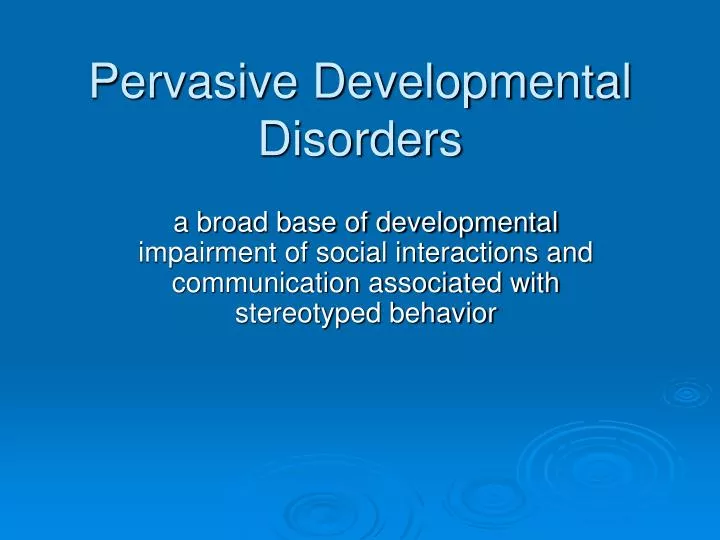

This condition has been linked to a defect on the X chromosome, so it almost always affects girls. They generally suffer the loss of many motor or movement, skills - such as walking and use of their hands - and develop poor coordination. Rett's syndrome: Children with this very rare disorder have the symptoms associated with a PDD and also suffer problems with physical development.In addition to the loss of social and language skills, a child with disintegrative disorder may lose control of other functions, including bowel and bladder control. At some point, usually between 2 and 10 years of age, a child with this illness loses many of the skills he or she has developed.

Childhood disintegrative disorder: Children with this rare condition begin their development normally in all areas, physical and mental.Children with Asperger's often also have difficulty concentrating and may have poor coordination. However, children with Asperger's have average or above average intelligence, and develop normally in the areas of language and cognition (the mental processes related to thinking and learning).
 Asperger's syndrome: Like children with autism, children with Asperger's syndrome have difficulty with social interaction and communication, and have a narrow range of interests. Many (nearly 75%) of children with autism also have some degree of mental retardation. They also have a limited range of activities and interests. Autism: Children with autism have problems with social interaction, pretend play, and communication. There are five types of pervasive development disorders: What Conditions Are Considered Pervasive Development Disorders? Although the condition begins far earlier than 3 years of age, parents often do not notice a problem until the child is a toddler who is not walking, talking, or developing as well as other children of the same age. Children with these conditions often are confused in their thinking and generally have problems understanding the world around them.īecause these conditions typically are identified in children around 3 years of age - a critical period in a child's development - they are called development disorders. The term "pervasive development disorders," also called PDDs, refers to a group of conditions that involve delays in the development of many basic skills, most notably the ability to socialize with others, to communicate, and to use imagination. Introduction to pervasive developmental disorders
Asperger's syndrome: Like children with autism, children with Asperger's syndrome have difficulty with social interaction and communication, and have a narrow range of interests. Many (nearly 75%) of children with autism also have some degree of mental retardation. They also have a limited range of activities and interests. Autism: Children with autism have problems with social interaction, pretend play, and communication. There are five types of pervasive development disorders: What Conditions Are Considered Pervasive Development Disorders? Although the condition begins far earlier than 3 years of age, parents often do not notice a problem until the child is a toddler who is not walking, talking, or developing as well as other children of the same age. Children with these conditions often are confused in their thinking and generally have problems understanding the world around them.īecause these conditions typically are identified in children around 3 years of age - a critical period in a child's development - they are called development disorders. The term "pervasive development disorders," also called PDDs, refers to a group of conditions that involve delays in the development of many basic skills, most notably the ability to socialize with others, to communicate, and to use imagination. Introduction to pervasive developmental disorders







 0 kommentar(er)
0 kommentar(er)
